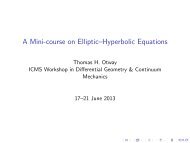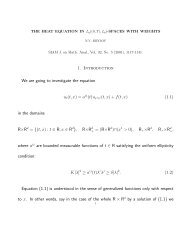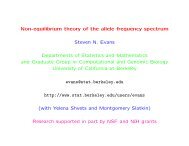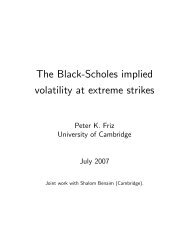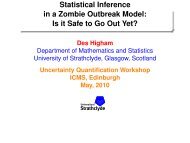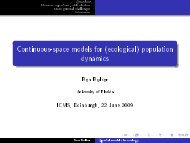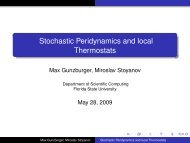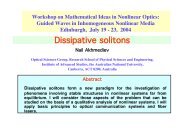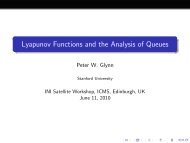Luc TARTAR Compensated Compactness with more ... - ICMS
Luc TARTAR Compensated Compactness with more ... - ICMS
Luc TARTAR Compensated Compactness with more ... - ICMS
You also want an ePaper? Increase the reach of your titles
YUMPU automatically turns print PDFs into web optimized ePapers that Google loves.
In 3-dimensional space-time one has H 1 ⊂ L 6 , so that a cubic<br />
term belongs to L 2 ; in 4-dimensional space-time one has H 1 ⊂<br />
L 4 , so that a quadratic term belongs to L 2 . It then suggests<br />
that an existence theorem should involve a solution being in<br />
H 1 in (x, t), which is not usual for a semi-group approach to<br />
semi-linear systems, which typically uses bounded functions in<br />
t <strong>with</strong> values in a Sobolev space of functions in x.<br />
In the beginning of 1985, BOSTICK (1916–1991) published an<br />
article on a conjectured toroidal shape for his “living electrons”.<br />
He used electromagnetism and the de Broglie’s wavelength of<br />
an electron, and a current having swirl.<br />
I thought that the coupled system of Dirac’s equation and the<br />
Maxwell–Heaviside equation might support a solution (exact<br />
or approximate) having such a toroidal structure.<br />
Since such a toroidal solution comes from dressing a particular<br />
geometrical curve (a circle) as a first term of an expansion, I<br />
thought that one could create other “particles” by starting from<br />
knotted curves; however, it would not be a problem of topology<br />
(of the embedding of the curve in R 3 ) but of geometry, the<br />
current going through the curve creating strong forces pushing<br />
the curve to prefer a particular geometrical pattern.<br />
It then reminds of an idea of THOMSON (1824–1907), known as<br />
Lord Kelvin after 1892, who wanted to describe the whole world<br />
<strong>with</strong> vortices, but replacing the equations of fluid dynamics by<br />
<strong>more</strong> basis hyperbolic systems. Of course, the (slightly silly)<br />
program of string theorists is also a revival of this dream, but<br />
my idea is to discover what type of solutions <strong>with</strong> oscillations<br />
are compatible <strong>with</strong> the coupled Dirac / Maxwell–Heaviside<br />
system, or <strong>more</strong> general hyperbolic systems, and not to invent<br />
games <strong>with</strong> geometrical objects and pretend that it is physics.<br />
20




